Jalousie window
A jalousie window (UK: /ˈdʒælʊziː/, US: /ˈdʒæləsiː/) or louvre window (Australia, New Zealand, Pacific Islands, Southeast Asia, United Kingdom) is a window composed of parallel glass, acrylic, or wooden louvres set in a frame. The louvres are joined onto a track so that they may be tilted open and shut in unison to control airflow, usually by turning a crank.
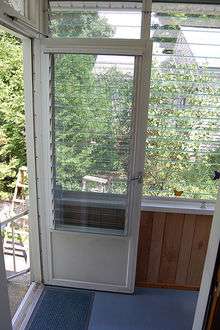
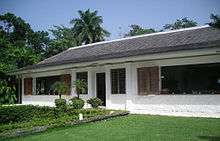
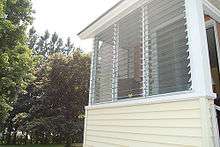
Etymology
Jalousie is the French word for jealousy. It originated in 18th century France from the Italian word geloso, which means jealous, or screen, as in to screen something from view.[1] Supposedly because of their slatted louvres, jalousie windows protect the interior of the house from jealous peering eyes.[2] However, the origin of Jalousie dates back to the mid-18th century, derived from the French word “Jealousy” – permitting one to see without being seen.[3]
Design
A patent for a basic louvered window was applied for in the US by a Joseph W. Walker, of Malden, Massachusetts, in 1900 and issued November 26, 1901, as patent no. 687705. A popular hand-cranked glass, aluminum, and screen window combination was later designed by American engineer Van Ellis Huff and found widespread use in temperate climates before the advent of air conditioning.[4] Jalousie windows were a popular feature in Mid-century modern houses, especially those built in warm and humid climates.[5]
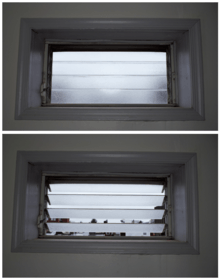
Use
Jalousie windows maximize natural ventilation by allowing airflow through the entire window area. Historically made only of wooden slats or glass panes, they are well suited to mild-winter climates.[6] With mass production they became very common throughout homes in mid-20th-century Florida, Hawaii, southern California, the deep South, and Latin America. In cooler regions they were rapidly adopted to porches and sunrooms. They were also widely used in mobile homes during the 1950s and 1960s before most manufacturers began switching to sliding and sash windows in subsequent decades.[7] Modern jalousie windows may be high-performance architectural windows, and some have even been featured in buildings which received awards for excellence in residential design and sustainable living.[8][9][10]Jalousie windows have evolved over time and these days can be seen as a design element as well as a technical device to utilize natural ventilation and temperature control. They are also used more widely in commercial projects.
Efficacy
A commonly accepted advantage of jalousie windows is their ability to be left part-way open in heavy rains as a way to maintain desirable ventilation, whether a sunshower or prolonged tropical storm. An experiment in 1960 tested the efficacy of jalousie windows in tropical climates to exclude rain while still allowing for air flow.[11] A major issue with excluding rain while allowing air flow is that both tend to come from the same direction. The angled slatted jalousie windows give the impression of solving this issue, however, the actual efficacy of the windows to let in air while keeping out water was deemed unsatisfactory by the study's authors.
Jalousie windows also have several other drawbacks.[12] Traditional style jalousie windows offer poor overall resistance to water penetration and drafts and are difficult to positively secure, as their slats are easily and silently removed. In addition to the inability to keep out water, they do not provide a secure barrier to keep air conditioned air inside. Also, the metal parts which make up the windows moving mechanism are prone to corrosion in humid environments, leading to damage such as broken or missing cranks. Jalousie windows are objects of scorn for many Floridians, as the windows are unable to keep out human and insect home invaders.[13]
Modern manufacturers have improved their designs of jalousie windows to address these problems. Many market their products as having greater security and energy efficiency compared to earlier versions.[14][15][16] The Australian company Breezeway, which began producing jalousie windows in 1935, is currently marketing jalousies which they claim creates an airtight seal when closed to keep out water and insects while keeping in air conditioned air.[17][18] Breezeway brand jalousies are made with non-corrosive hardware and a pinning system which keeps the slats secured from the interior of the house to increase security and prevent the slats from falling out. They are currently the only jalousie window in the United States certified to withstand a Category 5 Hurricane.[19]
Mid-century modern advertising
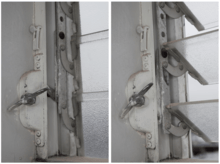
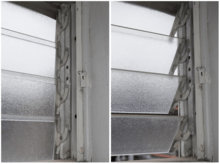
Many companies manufactured jalousie windows during the 20th century, and there are multiple surviving examples of advertisements from this period which demonstrate how the windows were marketed to consumers.[20] The advertisements tended to stress how jalousie windows provide ventilation, privacy, rain-proofing, and an extra room in winter. Companies like StormMaster claimed their jalousies provided "winter warmth and summer comfort."[21] Others, like Ludman WindoTite, promoted their product by declaring how the brand's windows have "transformed the Jones' front porch," which is an unambiguous reference to the concept of Keeping up with the Joneses.[21] The VentVue company took a different approach to their advertising copy, instead stressing how their jalousies make "every window a picture window," and states that they are fashionable choice for new constructions and replacements.[21]
See also
References
- "jalousie | Definition of jalousie in English by Oxford Dictionaries". Oxford Dictionaries | English. Retrieved 2018-12-15.
- "Jalousie windows, their history and where to buy them today - 21 photos from 1950". Retro Renovation. 2014-05-12. Retrieved 2018-12-15.
- "The History of Jalousie". SafetyLine Jalousie. 2018-08-29. Retrieved 2018-08-29.
- AP (December 16, 1987). "Van Ellis Huff, Inventor, 93". The New York Times.
- "Jalousie Jealousy: The Story of the Jalousie Window". The Craftsman Blog. 2017-01-23. Retrieved 2018-12-15.
- "Jalousie Windows - Replacement Window Costs - 2018 - Modernize". modernize.com. Retrieved 2018-12-15.
- "Mobile Home Windows - Replacement Costs". Modernize. 2017-01-10. Retrieved 2018-12-15.
- "Project". Breezway. Retrieved 31 December 2013.
- "Breeze Solarium House, Excellence in Sustainable Living". Retrieved 2018-12-15.
- "Open Spaced Topical Beachfront Oasis Utilising Breezway Louvres". Retrieved 2018-12-15.
- Koenigsberger, O.; Millar, J.S.; Costopolous, J. (1960). "WINDOW AND VENTILATOR OPENINGS IN WARM AND HUMID CLIMATES". Ekistics. 9 (56): 417–423. JSTOR 43617597.
- Polson, Mary Ellen (May 2017). "Postwar Challenges". Old House Journal: 42.
- Sentinel, Kathleen Parker, Orlando. "ONLY BURGLARS AND BUGS YEARN FOR THE JALOUSIE". chicagotribune.com. Retrieved 2018-12-15.
- "Jalousie". coastalwindows.com. Retrieved 2018-12-15.
- TheBurchCompany. "Jalousie Windows and Doors". The Burch Company. Retrieved 2018-12-15.
- "Jalousie Window - Tuscany® Series | Milgard Windows & Doors". www.milgard.com. Retrieved 2018-12-15.
- "About Breezway". breezway.com. Retrieved 2018-12-15.
- "Life's a "Breeze," Thanks to Latest Alternative to Jalousie Windows - Breezway". Hawaii Renovation. 2013-01-20. Retrieved 2018-12-15.
- "Life's a "Breeze," Thanks to Latest Alternative to Jalousie Windows - Breezway". Hawaii Renovation. 2013-01-20. Retrieved 2018-12-15.
- "Jalousie windows, their history and where to buy them today - 21 photos from 1950". Retro Renovation. 2014-05-12. Retrieved 2018-12-15.
- "Jalousie windows, their history and where to buy them today - 21 photos from 1950". Retro Renovation. 2014-05-12. Retrieved 2018-12-15.